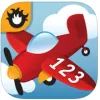Take a look inside 5 images
TallyTots
Pros: Cleverly designed interactive games make learning fun.
Cons: Needs better support for 1:1 counting correspondence; actually counting items would help.
Bottom Line: Well-designed games provide a fun and effective way to get kids interacting with and understanding numbers.
Kids will have lots of fun with these counting activities. Teachers should allow them to freely explore the game and investigate numbers and counting. Kids will get the most out of their experience if they play individually, although with no accounts, tracking, or targeted practice, teachers can't assign any particular number(s) or assess learning. To make the meaning of numbers clearer, teachers may want to have kids count aloud the items in each game. For example, one by one, point to each of the eight bottles in the activity for the number 8, counting 1, 2, 3…8, to drive home why there are exactly eight bottles on-screen. Extend number awareness offscreen by counting items in the classroom environment and encouraging students to talk about numbers and counting.
TallyTots allows kids to explore numbers, numerals, and counting order. Kids choose a number from 1 to 20 (e.g., 3) and watch and listen to all the numbers that lead up to that number (1-2-3). Then they hear simple instructions for an interactive game that involves the target number. For the number 3, for example, kids see three mice in bubbles and hear "Three white mice, see how they run." To play, kids drag each mouse across the screen. Other games involve playing a tune with eight bottles, using a magnifying glass to look closely at 14 "yummy" cupcakes, or watering five thirsty plants. When they've completed the task, kids can go forward or backward one number at a time, or tap and hold any number for four seconds to jump around. Bonus features include a number song and a counting board that helps kids count from 1 to 100.
TallyTots offers clever counting games that easily capture kids' attention. The appealing design gets kids intimately involved with counting, and repetition provides lots of reinforcement. These are effective games to help kids learn numbers and number order, and how to match number names with corresponding written numerals. Free-form exploration takes away any pressure on kids, although it also doesn't allow adults to get a sense of what kids are getting out of the play. Some simple additions would make these games even better: Kids do get a sense of what it looks like to have a specific number of items, but only a few games make clear the 1:1 correspondence between counting and the number of items. Simply adding audio and/or visuals that would help kids count the number of items as they interact with them would help drive home what counting and numbers really mean.












